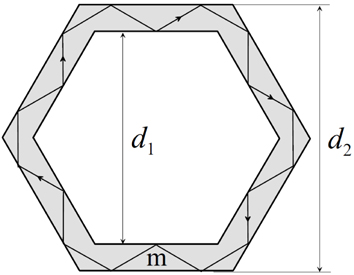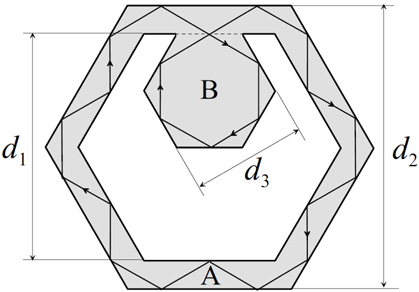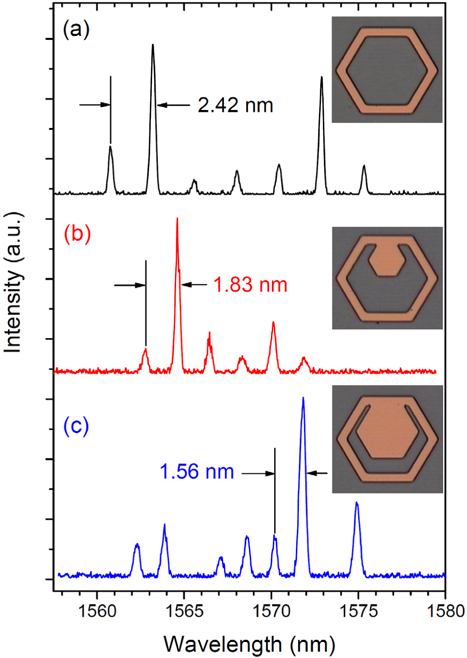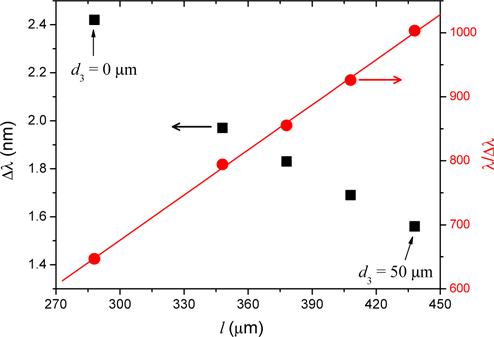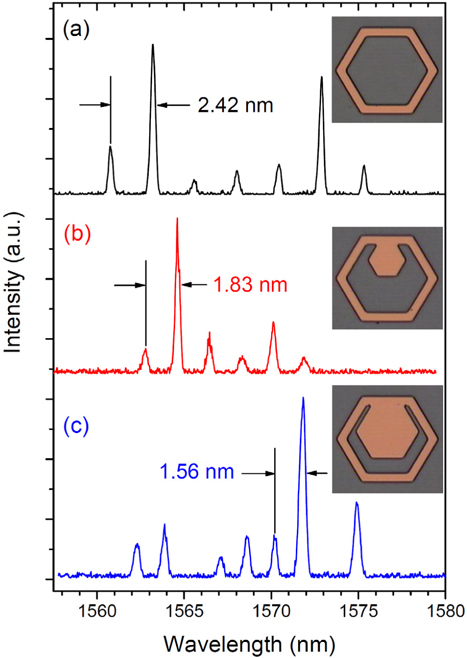



Coupled guided modes, proposed in various modified hollow hexagonal cavities each attached internally to a hexagon, were demonstrated by investigating the laser oscillations in semiconductor cavities. The mode spacing between two adjacent lasing peaks decreased as the size of the internal hexagon increased, due to the increased round-trip length of the coupled guided modes. The linear dependency of the inverse mode spacing to the calculated round-trip length strongly confirmed the lasing of the coupled guided modes. The proposed modes in common-sized external cavities showed resonance structure that could be adjusted widely by controlling the size of the internal hexagon.
Polygonal microcavities such as squares and hexagons, and polygonal ring cavities such as square ring cavities have attracted a great deal of interest due to the existence of whispering gallery (WG)-like modes, similar to WG modes in disk-type cavities, originating from the total internal reflection (TIR) of light at the boundaries [1-7]. Microcavities based on WG or WG-like modes are considered to be potential building blocks in photonic integrated circuits for optical filtering, switching, and microlasers [8-12]. Because the aforementioned cavities have flat sides, they present strong advantages, such as a long interaction length during coupling with external flat waveguides [13, 14].
Recently, a different type of WG-like modes called “guided modes” have been reported in hollow polygonal (square or hexagonal) geometries, wherein TIR occurs not only at the outer boundaries but also at the inner boundaries [15-17]. Figure 1 shows the previous hollow hexagonal cavity (outer size
If the inner size
where
where
One advantage of the guided modes is the tunable property of the resonance structure achieved by adjusting inner size
However, there is a limitation for the guided modes in a hollow polygonal cavity in an actual structure: The adjustable range
II. PROPOSED COUPLED GUIDED MODES
In this study, we propose a modified guided mode (denoted as a “coupled guided mode”) with a very large adjustable range in a modified hollow polygonal cavity, wherein a polygon is attached internally, so that the guided modes extend to the entire cavity. An example is shown in Fig. 2, in which a hexagon B (size
The guided modes in Fig. 1 extend to internal hexagon B, as depicted in Fig. 2. It is notable that there is no loss experienced by the light passing through the joint region, and this scheme is not limited in the wavelength of light. The elongation of the round-trip length by simply attaching the additional cavity is difficult to realize with other cavity geometries, such as MMI-coupled racetrack geometries [19]. If two racetrack cavities are coupled by MMI with a power coupling coefficient of ≅1, light can jump from one cavity to the other at the MMI coupler, resulting in the extension of the cavity modes, but the wavelengths satisfying ≅1 are limited to a small range because depends on the wavelength of the light. Moreover, there is the insertion loss of the MMI coupler. Thus the proposed scheme cannot be directly applied to racetrack geometries. The optical path length
Because
The experimental setup and epistructure used for the semiconductor cavities were similar to those in our previous studies [16, 17]. InGaAsP/InGaAs multiple quantum wells (MQWs,
Figure 3 shows typical lasing spectra, measured at ~3 times the threshold pump level, for hollow hexagonal external cavities (
The mode spacing Δ
where the group index
Because all the center wavelengths of the lasing spectra were similarly observed around 1565 nm in Fig. 3, the group index
Figure 4 summarizes the mode spacing Δ
In Fig. 4, the mode spacing Δ
To verify whether coupled guided modes exist for other sizes of the external cavity, various other external cavities were also designed and fabricated. Figure 5 shows typical lasing spectra with different common sizes (
The 18-bounce guided mode lasing in Fig. 5(a) appeared at ~ 1573 nm. The lasing peaks in Fig. 5(a) seem to be irregular as the mode spacing between several peaks on the left was not the same. This irregular feature should be attributed to the simultaneous lasing of coupled guided modes with two different polarizations (TE and TM). It is notable that the center wavelength of the lasing in Fig. 5(b) appeared at ~ 1563 nm, which is quite a bit shorter than that in Fig. 5(a). The center wavelength tends to appear in a lower absorption region (longer wavelength) as the total cavity loss decreases, as explained previously [17]. Thus the blue-shift of the center wavelength implies that the total cavity loss of the resonance modes increased. One reason might be the larger bouncing number of the 22-bounce coupled guided modes than the 18-bounce guided modes. More frequent bouncing during one round trip will yield a much greater total loss because scattering loss in the TIR process comes from the roughness of the etched surface. However, this seems unlikely because an apparent blue-shift was not observed in Fig. 3 for the same increase in bouncing number.
The other plausible origin is due to the smaller side length of the internal hexagon. Due to the Goos-Hänchen effect, a ray-propagation distance exists for the TIR process at the flat boundary [18]. Thus an evanescent wave exists along the flat side within a finite length of propagation. The evanescent wave could leak from the boundary corner. As the flat side length of the internal hexagon becomes smaller, more evanescent leakage loss from the corner is expected. Therefore, the quality factor Q of the coupled guided modes will be rapidly spoiled when
In conclusion, resonance modes called coupled guided modes were proposed in a hollow polygonal cavity in which an additional polygon is attached internally. In the case of a hollow hexagonal cavity, 18-bounce guided modes were modified to 22-bounce coupled guided modes using an internal hexagon to extend the round-trip length. The proposed coupled guided modes were demonstrated by investigating the lasing spectra in various semiconductor cavities. The adjustable range in the mode spacing became about 10 times larger than for the previous guided modes, which will be beneficial for tunable photonic building blocks with common outer size. This scheme can be expanded to different polygonal shapes, such as square and octagonal geometries.
